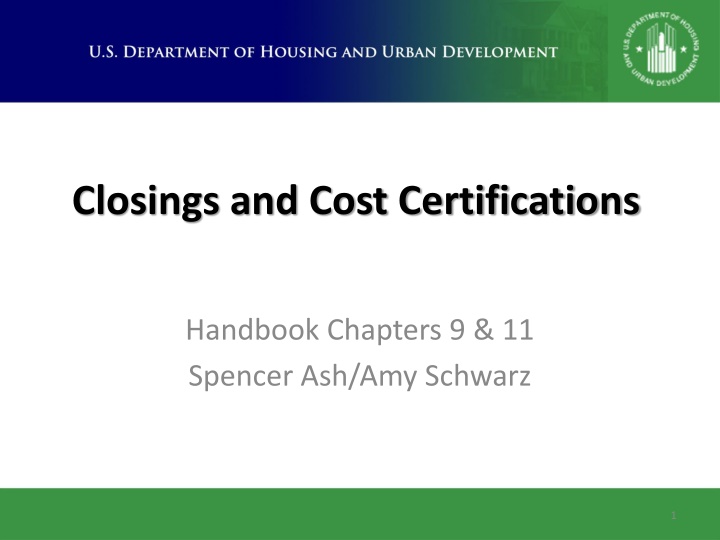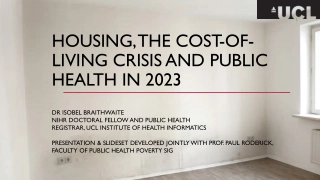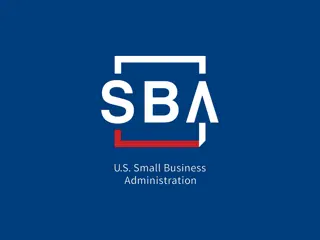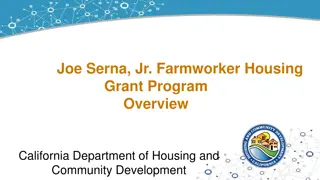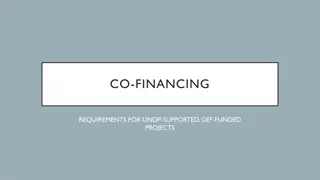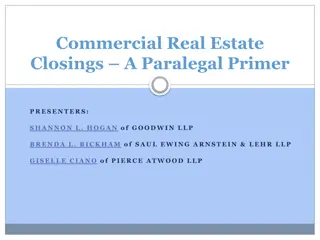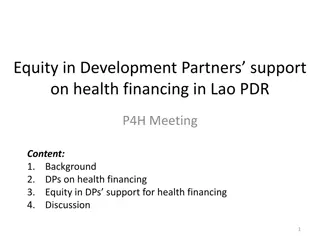Guide to Closings and Cost Certifications in Housing Financing
Explore the handbook chapters covering the closing process, cost certification requirements, and nuances for different loan types in housing financing. Learn about the roles of various players and the importance of final cost certification before closing. Detailed explanations and images are provided to clarify key points.
Download Presentation

Please find below an Image/Link to download the presentation.
The content on the website is provided AS IS for your information and personal use only. It may not be sold, licensed, or shared on other websites without obtaining consent from the author.If you encounter any issues during the download, it is possible that the publisher has removed the file from their server.
You are allowed to download the files provided on this website for personal or commercial use, subject to the condition that they are used lawfully. All files are the property of their respective owners.
The content on the website is provided AS IS for your information and personal use only. It may not be sold, licensed, or shared on other websites without obtaining consent from the author.
E N D
Presentation Transcript
Closings and Cost Certifications Handbook Chapters 9 & 11 Spencer Ash/Amy Schwarz 1
ORCFs Closing Team and OGC keeping the conveyor belt of closing moving! In FY 2013 we had 766 closings, compared to 706 in FY 2012, 415 in FY 2011, and 309 in FY 2010 So far this fiscal year: 2
BEFORE CLOSING COST CERTIFICATION! Prior to final closing, the final eligible mortgage costs must be certified by both the Lender and the Borrower. Purpose of a cost certification: Establish the Borrower s actual costs, including the contractor s cost, Establish the maximum insurable loan for Final Closing of the insured mortgage 3
Cost Certification (Continued) Things to keep in mind for Cost Certification: Know what is required and when! See Chapter 11 for specifics 223(a)(7): Not required 223(f): Remember to use new form, Borrower s Certificate of Actual Cost, HUD-2205A-ORCF 4
Cost Certification (Continued) New Construction Changes under ORCF 232 Program: Cost Certification review is the responsibility of the Lender. ORCF Closing Coordinator will review Lender s conclusion and final loan determination based on submitted documentation. Section 232 Handbook, Chapter 11, Section 11.10 and Email Blast of January 6, 2012, list required forms & documentation. The Maximum Insurable Mortgage Letter has replaced Form HUD-2580, Maximum Insurable Mortgage. A sample letter is attached to the January 6, 2012 Email Blast, or can be requested from the assigned ORCF Closing Coordinator. 5
Closing Process & Players Closing Process: Section 232 Handbook, Chapter 9 Firm Commitment to Closing ( 9.2- 9.4) Players: ORCF Closer ( 9.2) OGC Attorney Lender and Lender s Attorney ( 9.3) 6
Closing Nuances By Loan Type Closing Section 232/223(a)(7) Loans ( 9.6) Closing Section 232/223(f) Loans ( 9.6) Closing New Construction Loans ( 9.7) Initial Closing ( 9.8) Final Closing ( 9.11) 7
OGC Part I Document Review One part review replaces Part 1 & Part 2 process Exception Upfront OGC review required for transactions involving: AR Financing Portfolios Master Leases Other complex legal issues (ORCF UW may request when a legal issue could impact a Loan Committee Decision) 8
ORCF Process & Review Assignments: ORCF Closers assigned when closing packages are complete and ready to submit to OGC Attorney When legal closing package is sent to the assigned OGC Attorney, email ORCFCloser@hud.gov for a Closer assignment (9/26/13 Email Blast) New Documents: Required for all closings with Firm Commitments on or after July 12, 2013 (9/26/13 Email Blast) 9
ORCF Process & Review Signing of Closing Documents: Critical any and all communications regarding execution of closing documents must go through ONLY the assigned Closers/GTM Closers to prevent delays in the closing process (9/26/13 Email Blast) Transaccess ( 9.4.F): Notify assigned Closer by email and copy Transaccess@hud.gov when Transaccess CD/document has been sent (5/7/14 Email Blast) 10
Tips for a Successful Closing Complete draft closing documents ( 9.2) Get your attorney involved early Use ORCF resources(Appendix 9.1): Closer Closing Checklist Attorney Closing Checklist Attorney Punchlist Special Condition Matrix 11
Tips (Continued) Amendments and Extensions: 9.2.B and 9.3 B.1 Prior to ORCF Closer assignment, send any requests for extensions to ORCFCloser@hud.gov 12
Tips (Continued) Lender s Attorney is responsible for closing documents and responses to HUD comments. Please ensure Lender s Attorney is coordinating with Borrower/Operator Attorneys and reviews the documents they prepare before submitting to HUD. Revisions to standard OMB approved documents should be rare. If revisions proposed for closing, or waiver needed after Firm is issued, they should be submitted early in closing review (as part of the first submission of draft documents.) Signing of documents can take some time! Factor in # of days needed for pre-recording. Take this into consideration when proposing closing date. 13
Closing Docs Closing Table Partnership & Collaboration Remember: Complete, clean, & accurate closing packages get reviewed and closed quicker All special conditions must be met and properly documented prior to closing Use the Special Conditions Matrix! Responsiveness to ORCF Closer and OGC Attorney and fast turnaround is KEY ORCFCloser@hud.gov 14
Hot Topics & Updates Requests to make changes to HUD documents: Requests for revisions use Form Deal-Specific Change Request Protocol Request for Endorsement, Section I(D)(1) Closing Statements Sources & Uses for 223(f) and 223(a)(7) Implemented to provide greater consistency, can use Sources & Uses as the loan closing statement for 223(f) or 223 (a)7 closings (2/24/14 Email Blast) Provides greater consistency in Lenders submissions Expedites the ORCF Closers review of closing statements and finalization of closing documents Amounts used for the Sources & Uses/closing statement must be exact, carried out 2 decimal places Checks for MIP and inspection fee delivered at closing must be for the exact amounts due HUD (June 27, 2014, Email Blast and Section 9.3.F) 15
Litigation/Docket Searches February 27, 2014 Email Blast ORCF no longer collects litigation searches (except where required by the Attorney s Opinion as an Exhibit) As required by the attorney s opinions, litigation searches must be run within 30 days of endorsement 16
Litigation/Docket Searches Newly discovered litigation (not previously disclosed to ORCF in the application process), Lender must immediately address for each newly discovered lawsuit: Name and discussion of each, including estimated potential liability; Whether each suit is covered by insurance or is for a claim not covered by insurance; Amount of liability insurance available to cover each lawsuit, other pending claims and judgments, and estimated potential liability for other lawsuits/judgments; and Identify who bears the cost of defense of each new lawsuit and whether insurance company is participating in the defense. 17
Firm Commitment Material Adverse Change Para. 22 This Commitment is conditioned upon and shall not be enforceable against HUD until and unless all conditions to Endorsement stated herein have been satisfied or waived by HUD. HUD reserves the right to suspend processing or terminate this Commitment in the event that any of the factors (a)-(d) listed in paragraph 23 below occur prior to Endorsement. Para 23. Prior to Endorsement, the Borrower and Operator must certify that between issuance of Firm Commitment and closing, none of the following have occurred: (a) federal, state, municipal and or other regulatory authority action against the project that demonstrates or alleges substantial deficiencies in the operation of the project which may be evidenced by an administrative or judicial proceeding or final audit finding; (b) filing of a bankruptcy petition of mortgagor, or operator; (c) filing of a lawsuit or criminal charges against the operator or mortgagor entity or any principal thereof; or (d) placement of a Special Focus Designation or ban on new admissions on the project. 18
Hot Topics & Updates (Continued) Difference between Owner and an Identity of Interest Owner/Operator Regulatory Agreement, Section 38 Survey and pre-existing survey certification Revised documents 19
Questions 20
